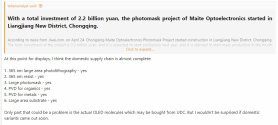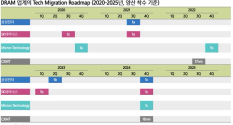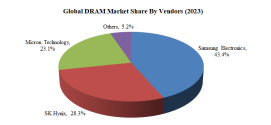You are using an out of date browser. It may not display this or other websites correctly.
You should upgrade or use an alternative browser.
You should upgrade or use an alternative browser.
Chinese semiconductor thread II
- Thread starter vincent
- Start date
The indigenization progress on equipment and material at Chinese display sector LCD/OLED is extremely slow.
As this article pointed out,Chinese equipment manufactures all rush into semiconductor sector,not much attention is being paid at display sector. And the gov doesn't seem to concern about low level upstream indigenization in display sector either.
I think the reason for the stark contrast between the rapid rise of domestic manufactures in semiconductor sector and the slow progress in
display sector,is that the display sector never have a sense of insecurity(being cut off from oversea suppliers) but the semiconductor sector does.
The indigenization progress of semiconductor and display industry were pretty similar prior to 2019,then they start to split for well known reason. Semiconductor industry entered turbocharge mode on domestic supply chain,where as the display industry still go on business-as-usual.
The story of Chinese semiconductor industry is a good example of short term pain for long term gain. The question is,why do you have to wait for someone else to stab you to wake you up,to have that “short term pain”? Why don't you stab yourself before some else does (ie. ban critical imports before others impose export ban)?
People have unrealized potential,and that potential can only be realized when they are being pushed to the limit. This is true for most of Chinese high-tech industries,you put them in a do-or-die situation,they will figure out a way for self-salvation
As this article pointed out,Chinese equipment manufactures all rush into semiconductor sector,not much attention is being paid at display sector. And the gov doesn't seem to concern about low level upstream indigenization in display sector either.
I think the reason for the stark contrast between the rapid rise of domestic manufactures in semiconductor sector and the slow progress in
display sector,is that the display sector never have a sense of insecurity(being cut off from oversea suppliers) but the semiconductor sector does.
The indigenization progress of semiconductor and display industry were pretty similar prior to 2019,then they start to split for well known reason. Semiconductor industry entered turbocharge mode on domestic supply chain,where as the display industry still go on business-as-usual.
背板制作的大部分设备与传统的半导体制程设备相似,但考虑到玻璃基板的尺寸比半导体晶圆要大得多,对设备的大型化要求比较高。中国的半导体厂商目前主要精力放在半导体设备的国产化上,对显示领域制程设备的国产化需求感觉不是很强烈,在设备的国产替代方面进展缓慢。
The story of Chinese semiconductor industry is a good example of short term pain for long term gain. The question is,why do you have to wait for someone else to stab you to wake you up,to have that “short term pain”? Why don't you stab yourself before some else does (ie. ban critical imports before others impose export ban)?
People have unrealized potential,and that potential can only be realized when they are being pushed to the limit. This is true for most of Chinese high-tech industries,you put them in a do-or-die situation,they will figure out a way for self-salvation
Last edited:
Looks like in the private-commercial sector only move under extreme pressure, even when ZTE was under the threat of being killed by US sanctions in 2017 nothing changed, China industrialists thought that will never happen to them and those include Huawei management. The Chinese government also was somehow slow to act, they pay for the R&D and commercialization of semiconductor manufacturing tools but they can't force managers to buy SMEE I-Line scanners instead of ASML ones and much less when those managers are foreign. I think the best strategy for China was and still is a dual approach. MEMs, Power ICs and mature logic nodes should be as close to 100% domestic as possible leaving foreign tools, software and materials just to the leading edge. So in that case under a threat of sanctions could allow China to quickly fill the gaps. Imagine SMEE dry scanners (KrF, ArF, I-Line) being use more while ASML have only be allow to sell immersion and EUV scanners, in that case if ASML tools get sanctioned SMEE could have filled the gap a lot quicker and probably half decade ago.The indigenization progress on equipment and material at Chinese display sector LCD/OLED is extremely slow.
As this article pointed out,Chinese equipment manufactures all rush into semiconductor sector,not much attention is being paid at display sector. And the gov doesn't seem to concern about low level upstream indigenization in display sector either.
I think the reason for the stark contrast between the rapid rise of domestic manufactures in semiconductor sector and the slow progress in
display sector,is that the display sector never have a sense of insecurity(being cut off from oversea suppliers) but the semiconductor sector does.
The indigenization progress of semiconductor and display industry were pretty similar prior to 2019,then they start to split for well known reason. Semiconductor industry entered turbocharge mode on domestic supply chain,where as the display industry still go on business-as-usual.
The story of Chinese semiconductor industry is a good example of short term pain for long term gain. The question is,why do you have to wait for someone else to stab you to wake you up,to have that “short term pain”? Why don't you stab yourself before some else does (ie. ban critical imports before others impose export ban)?
People have unrealized potential,and that potential can only be realized when they are being pushed to the limit. This is true for most of Chinese high-tech industries,you put them in a do-or-die situation,they will figure out a way for self-salvation
Laser self-reference technique for high-precision lithographic alignment.
Abstract
Tsinghua Univ.Achieving nanometer-level alignment precision in lithography is essential for the advancement of semiconductor manufacturing. This study introduces an innovative laser self-reference technique that leverages the interference of two coherent beams on a reflective grating with a matching period. By incorporating a wedge-shaped beam splitter, a reference interference fringe is generated, establishing a direct correlation between the incident interference pattern and the reference grating, thus enabling real-time spatial alignment monitoring. A theoretical model was developed to elucidate the phase relationship. The experimental apparatus comprised a high-precision laser system, a piezoelectric transducer (PZT) for minute phase adjustments, and a high-speed CMOS camera for instantaneous analysis. The technique was evaluated using three displacement inversion algorithms, with the image phase correlation algorithm outperforming the others, achieving control of deviations to below 3.2 nm. Laser self-referencing technology not only provides a nanoscale alignment method, but also meets the fine control required for multi-layer grating manufacturing, improving the quality and reliability of the lithography process, and addressing a critical challenge in the production of semiconductor chips. |
you know what, i have only one problem with these random websites. they literally don't know the latest trend and update. sometimes i don't even believe on flagship websites like CGTN/Globaltimes. that's because Journalists literally don't know anything.Looks like in the private-commercial sector only move under extreme pressure, even when ZTE was under the threat of being killed by US sanctions in 2017 nothing changed, China industrialists thought that will never happen to them and those include Huawei management. The Chinese government also was somehow slow to act, they pay for the R&D and commercialization of semiconductor manufacturing tools but they can't force managers to buy SMEE I-Line scanners instead of ASML ones and much less when those managers are foreign. I think the best strategy for China was and still is a dual approach. MEMs, Power ICs and mature logic nodes should be as close to 100% domestic as possible leaving foreign tools, software and materials just to the leading edge. So in that case under a threat of sanctions could allow China to quickly fill the gaps. Imagine SMEE dry scanners (KrF, ArF, I-Line) being use more while ASML have only be allow to sell immersion and EUV scanners, in that case if ASML tools get sanctioned SMEE could have filled the gap a lot quicker and probably half decade ago.
this is actually the major concern. maybe they are lazy they don't want to track day to day updates just like us.
****************************************************************************************************
in March, 2023 we have tracked display industry local supply chain and look.

------------------------------------------------------------------
in January, 2023..
For the first time, China broke the Japanese monopoly and mass-produced FMM, a key material for OLED displays
--------------------------------------------------------------------
Jihua Laboratory has made a major breakthrough in the research of high-resolution OLED inkjet printing equipment
The team spent more than 3 years and successively achieved breakthroughs in macro-volume inkjet printing synchronous collaborative control technology, large-scale cavity multi-physics and high stability It has formed a unique inkjet printing technology solution using a number of key core technologies such as sex controllable technology, high-precision alignment system, and high-precision circulating ink supply system. It has successfully developed a complete set of 200mm×200mm OLED inkjet printing equipment and achieved 7 The full-color printing and lighting of 137-inch 137ppi substrates, the printing and UV testing of 5-inch 254ppi and 300ppi substrates mark the first time that my country's independent equipment has achieved high-resolution printing of 300ppi, and its performance has reached the international advanced level.
------------------------------------------------------------------------

i have much more to share but its enough now
Display supply chain is basically localized. but the market share is a different thing.
Good opportunity for SMIC or Huawei to pick up talent imho. Sure, Samsung's advanced node yields are poor but through their human capital you can learn from missteps and avoid alot of trial and error for future rollout and improvement at advanced nodes. Will save both time and money, plus it provides an opportunity for knowledge transfer and training of fresh workforce from experienced hands.Chinese Ai firms will suffer no doubt on this.. but the bigger picture is, it will be death sentence for Samsung as they already struggling. planning to cut off 50% of its facilities by the end of the year.
looks like in 2030's we will have only two chip giants remains. TSMC/SMIC... SS will be distant 3rd or could be lower.
So according to this,there actually was an export ban on 12-inch equipment from the US to China. The time was during China's transition from 8-inch to 12-inch,so it's probably early 2000s
中国半导体行业经历了从学习到创新再到突破的过程。我记得国内企业在做8吋设备的时候,12吋设备美国对中国是禁运的,有一家上海公司,他们想建一条12吋生产线,结果因为买不到对应的设备,后面只能改成8吋生产线。后来经过五六年的努力,我们开发出第一台12吋设备,美国马上就将12吋设备禁令解除了。当时我们第一台国产设备交付客户端的时候,很多工程师像参观一样过来看这台国产设备,当时感觉很震惊也很骄傲,因为在整个大工厂中,上千台设备里只有这一台国产设备。
The Chinese semiconductor industry has gone through a process from learning to innovation and then to breakthrough. I remember when domestic companies were making 8-inch equipment, the United States had an embargo on 12-inch equipment to China. There was a Shanghai company that wanted to build a 12-inch production line, but because they couldn't buy the corresponding equipment, they had to change to an 8-inch production line. After five or six years of hard work, we developed the first 12-inch equipment, and the United States immediately lifted the ban on 12-inch equipment. When our first domestically produced equipment was delivered to the client, many engineers came to see this domestically produced equipment as if they were visiting. At the time, I felt shocked and proud, because in the entire large factory, there was only this one domestically produced equipment among thousands of equipment.
中国半导体行业经历了从学习到创新再到突破的过程。我记得国内企业在做8吋设备的时候,12吋设备美国对中国是禁运的,有一家上海公司,他们想建一条12吋生产线,结果因为买不到对应的设备,后面只能改成8吋生产线。后来经过五六年的努力,我们开发出第一台12吋设备,美国马上就将12吋设备禁令解除了。当时我们第一台国产设备交付客户端的时候,很多工程师像参观一样过来看这台国产设备,当时感觉很震惊也很骄傲,因为在整个大工厂中,上千台设备里只有这一台国产设备。
The Chinese semiconductor industry has gone through a process from learning to innovation and then to breakthrough. I remember when domestic companies were making 8-inch equipment, the United States had an embargo on 12-inch equipment to China. There was a Shanghai company that wanted to build a 12-inch production line, but because they couldn't buy the corresponding equipment, they had to change to an 8-inch production line. After five or six years of hard work, we developed the first 12-inch equipment, and the United States immediately lifted the ban on 12-inch equipment. When our first domestically produced equipment was delivered to the client, many engineers came to see this domestically produced equipment as if they were visiting. At the time, I felt shocked and proud, because in the entire large factory, there was only this one domestically produced equipment among thousands of equipment.
That is right. According to the Wassenaar Arrangement China was to be kept perpetually two process nodes behind.
Then for whatever reason they lifted those restrictions but now they put them back, except it is even more restrictive, since the US put a hard fixed ceiling on what can be imported by China, instead of the two process nodes behind.
Then for whatever reason they lifted those restrictions but now they put them back, except it is even more restrictive, since the US put a hard fixed ceiling on what can be imported by China, instead of the two process nodes behind.
Robosense has developed its own Lidar specific SoC for M series Lidars. These Lidars use 2D MEMS chip and SPAD-SoC using 3D stacking technique.
Hope they speed up the progress,because at the moment Robosense Lidar can hardly be called "domestic" product based on it's high foreign contents




